
In March 2008, on a remote Norwegian island in the Arctic Circle, the Svalbard Global Seed Vault, or “doomsday vault,” took its first deposits. The vault’s builders had spent some $7 million and 12 months blasting a tunnel and three chambers into the mountainside’s hard permafrost. To be stored within? Treasure.
The doomsday vault keeps the world’s agricultural heritage in deep freeze. Six years on, and after a recent deposit of 20,000 species, the vault now houses over 800,000 plant species, and with an average 500 seeds per sample, some 400 million seeds.
That may sound like a lot, but the doomsday vault was designed to store more. A lot more. At full capacity, in drawers lining the walls of its three chambers, the vault can fit 4.5 million species and some 2.25 billion seeds.
Think of the doomsday vault as the external hard drive backing up the genetic data of the world’s plant-based food. Or, if you prefer, a modern day Noah’s Ark for wheat, corn, rice, the world’s agricultural species in all their diversity.
In addition to civilization ending disasters, nuclear war, asteroid or comet strike, biblical floods, zombies, the world’s 1,400 genebanks and their precious seed stores are susceptible to war, poor management, and natural disasters.
